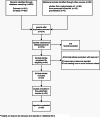Diagnostic accuracy of case-identification algorithms for heart failure in the general population using routinely collected health data: a systematic review
- PMID: 39716260
- PMCID: PMC11668106
- DOI: 10.1186/s13643-024-02717-8
Diagnostic accuracy of case-identification algorithms for heart failure in the general population using routinely collected health data: a systematic review
Abstract
Background: Heart failure (HF), affecting 1-4% of adults in industrialized countries, is a major public health priority. Several algorithms based on administrative health data (HAD) have been developed to detect patients with HF in a timely and inexpensive manner, in order to perform real-world studies at the population level. However, their reported diagnostic accuracy is highly variable.
Objective: To assess the diagnostic accuracy of validated HAD-based algorithms for detecting HF, compared to clinical diagnosis, and to investigate causes of heterogeneity.
Methods: We included all diagnostic accuracy studies that utilized HAD for the diagnosis of congestive HF in the general adult population, using clinical examination or chart review as the reference standard. A systematic search of MEDLINE (1946-2023) and Embase (1947-2023) was conducted, without restrictions. The QUADAS-2 tool was employed to assess the risk of bias and concerns regarding applicability. Due to low-quality issues of the primary studies, associated with both the index test and the reference standard definition and conduct, and to the high level of clinical heterogeneity, a quantitative synthesis was not performed. Measures of diagnostic accuracy of the included algorithms were summarized narratively and presented graphically, by population subgroups.
Results: We included 24 studies (161,524 patients) and extracted 36 algorithms. Algorithm selection was based on type of administrative data and DOR. Six studies (103,018 patients, 14 algorithms) were performed in the general outpatient population, with sensitivities ranging from 24.8 to 97.3% and specificities ranging from 35.6 to 99.5%. Eight studies (14,957 patients, 10 algorithms) included hospitalized patients with sensitivities ranging from 29.0 to 96.0% and specificities ranging from 65.8 to 99.2%. The remaining studies included subgroups of the general population or hospitalized patients with cardiologic conditions and were analyzed separately. Fourteen studies had one or more domains at high risk of bias, and there were concerns regarding applicability in 9 studies.
Discussion: The considerable percentage of studies with a high risk of bias, together with the high clinical heterogeneity among different studies, did not allow to generate a pooled estimate of diagnostic accuracy for HAD-based algorithms to be used in an unselected general adult population.
Systematic review registration: PROSPERO CRD42023487565.
Keywords: Administrative health data; Case-detection algorithms; Diagnostic accuracy systematic review; Health claims; Heart failure.
© 2024. The Author(s).
Conflict of interest statement
Declarations. Ethics approval and consent to participate: The study concerns literature-based studies. Therefore, ethical approval and informed consent were not required. Consent for publication: Not applicable. Competing interests: The authors declare that they have no competing interests.
Figures





References
-
- Bozkurt B, Coats AJS, Tsutsui H, et al. Universal definition and classification of heart failure: a report of the Heart Failure Society of America, Heart Failure Association of the European Society of Cardiology, Japanese Heart Failure Society and Writing Committee of the Universal Definition of Heart Failure: endorsed by the Canadian Heart Failure Society, Heart Failure Association of India, Cardiac Society of Australia and New Zealand, and Chinese Heart Failure Association. Eur J Heart Fail. 2021;23(3):352–80. 10.1002/ejhf.2115. - PubMed
-
- Savarese G, Becher PM, Lund LH, Seferovic P, Rosano GMC, Coats AJS. Global burden of heart failure: a comprehensive and updated review of epidemiology. Cardiovasc Res. 2023;118(17):3272–87. 10.1093/cvr/cvac013. - PubMed
-
- Cowper DC, Hynes DM, Kubal JD, Murphy PA. Using administrative databases for outcomes research: select examples from VA Health Services Research and Development. J Med Syst. 1999;23(3):249–59. 10.1023/a:1020579806511. - PubMed
-
- Jutte DP, Roos LL, Brownell MD. Administrative record linkage as a tool for public health research. Annu Rev Public Health. 2011;32(1):91–108. 10.1146/annurev-publhealth-031210-100700. - PubMed
Publication types
MeSH terms
LinkOut - more resources
Full Text Sources
Medical
Research Materials
Miscellaneous

